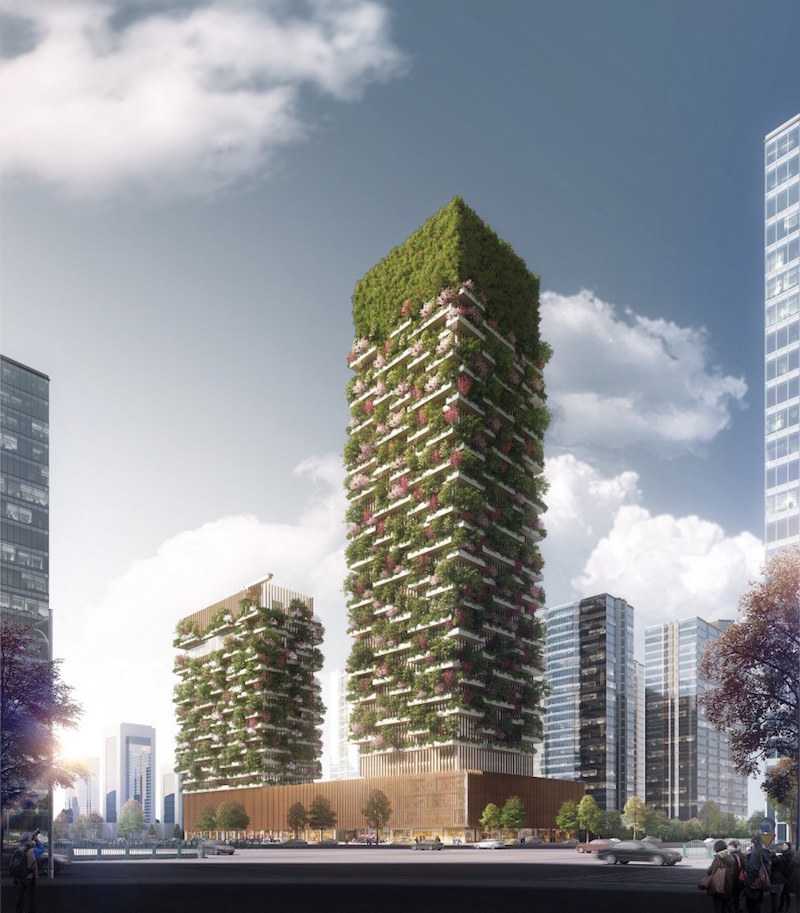A new mixed-use project from Stefano Boeri Architects, Nanjing Vertical Forest will comprise two towers rising from a 20-meter shared podium. What makes this project unique is, according to the architects, this will be the first vertical forest built not only in China, but in all of Asia.
The building’s facades will feature 600 tall trees and 500 medium trees from 23 different local species. Another 2,500 cascading plants and shrubs will be included, as well. In total, the trees and other plants will cover a 6 square mile area and absorb 25 tons of CO2 per year. The plants will also produce about 60 kilograms of oxygen per day. To help put that into perspective, the average person needs 0.84 kilograms of oxygen per day, according to NASA.
One of the towers will rise 200 meters and be topped with a “green lantern” while the other tower will rise 108 meters. The 200-meter tower will include a museum, a green architecture school, and a private rooftop club. The 108-meter tower will house a 247-room Hyatt hotel and a rooftop swimming pool. Both towers will rise from a 20-meter podium that will host retail space, a food market, restaurants, a conference hall, and exhibition spaces.
The project is Stefano Boeri Architects’ third vertical forest prototype, after Milan and Lausanne. The firm plans to bring vertical forests to other Chinese cities such as Guizhou, Shanghai, and Chongqing at a later date. The Nanjing Vertical Forest will be completed in 2018.
 Rendering courtesy of Stefano Boeri Architects.
Rendering courtesy of Stefano Boeri Architects.
 Rendering courtesy of Stefano Boeri Architects.
Rendering courtesy of Stefano Boeri Architects.
Related Stories
Mass Timber | May 31, 2024
Mass timber a big part of Western Washington University’s net-zero ambitions
Western Washington University, in Bellingham, Wash., 90 miles from Seattle, is in the process of expanding its ABET-accredited programs for electrical engineering, computer engineering and science, and energy science. As part of that process, the university is building Kaiser Borsari Hall, the 54,000-sf new home for those academic disciplines that will include teaching labs, research labs, classrooms, collaborative spaces, and administrative offices.
MFPRO+ New Projects | May 29, 2024
Two San Francisco multifamily high rises install onsite water recycling systems
Two high-rise apartment buildings in San Francisco have installed onsite water recycling systems that will reuse a total of 3.9 million gallons of wastewater annually. The recycled water will be used for toilet flushing, cooling towers, and landscape irrigation to significantly reduce water usage in both buildings.
MFPRO+ News | May 28, 2024
ENERGY STAR NextGen Certification for New Homes and Apartments launched
The U.S. Environmental Protection Agency recently launched ENERGY STAR NextGen Certified Homes and Apartments, a voluntary certification program for new residential buildings. The program will increase national energy and emissions savings by accelerating the building industry’s adoption of advanced, energy-efficient technologies, according to an EPA news release.
HVAC | May 28, 2024
Department of Energy unveils resources for deploying heat pumps in commercial buildings
To accelerate adoption of heat pump technology in commercial buildings, the U.S. Department of Energy is offering resources and guidance for stakeholders. DOE aims to help commercial building owners and operators reduce greenhouse gas emissions and operating costs by increasing the adoption of existing and emerging heat pump technologies.
Resiliency | May 24, 2024
As temperatures underground rise, so do risks to commercial buildings
Heat created by underground structures is increasing the risk of damage to buildings, recent studies have found. Basements, train tunnels, sewers, and other underground systems are making the ground around them warmer, which causes soil, sand, clay and silt to shift, settle, contract, and expand.
Senior Living Design | May 16, 2024
Healthy senior living campus ‘redefines the experience of aging’
MBH Architects, in collaboration with Eden Housing and Van Meter Williams Pollack LLP, announces the completion of Vivalon’s Healthy Aging Campus, a forward-looking project designed to redefine the experience of aging in Marin County.
Sustainability | May 10, 2024
Perkins&Will’s first ESG report discloses operational performance data across key metrics
Perkins&Will recently released its first ESG report that discloses the firm’s operational performance data across key metrics and assesses its strengths and opportunities.
Sustainable Development | May 10, 2024
Nature as the city: Why it’s time for a new framework to guide development
NBBJ leaders Jonathan Ward and Margaret Montgomery explore five inspirational ideas they are actively integrating into projects to ensure more healthy, natural cities.
K-12 Schools | May 7, 2024
World's first K-12 school to achieve both LEED for Schools Platinum and WELL Platinum
A new K-12 school in Washington, D.C., is the first school in the world to achieve both LEED for Schools Platinum and WELL Platinum, according to its architect, Perkins Eastman. The John Lewis Elementary School is also the first school in the District of Columbia designed to achieve net-zero energy (NZE).
K-12 Schools | Apr 30, 2024
Fully electric Oregon elementary school aims for resilience with microgrid design
The River Grove Elementary School in Oregon was designed for net-zero carbon and resiliency to seismic events, storms, and wildfire. The roughly 82,000-sf school in a Portland suburb will feature a microgrid—a small-scale power grid that operates independently from the area’s electric grid.

















